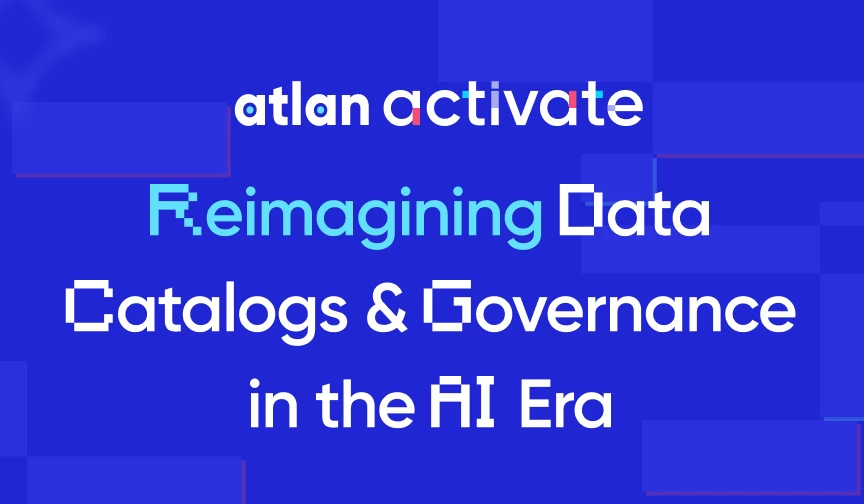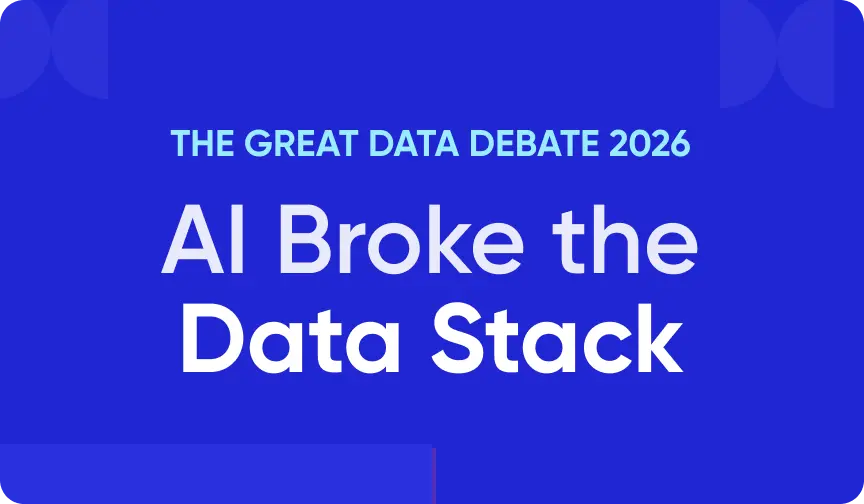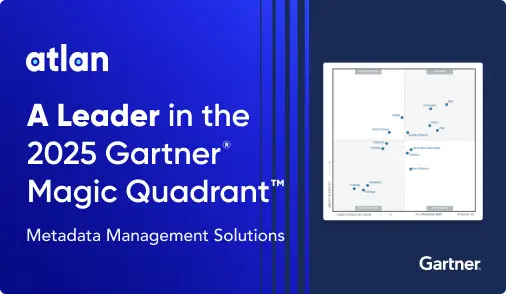Data Policy Setting Tools: Must-Have Product Capabilities in 2025
Share this article
Data policy setting tools define, approve, enforce, and monitor governance policies across your data and analytics assets. According to Gartner, these tools ‘operationalize, serve and automate the work of the governance board in policy setting.’
See How Atlan Simplifies Data Governance ✨ – Start Product Tour
This article explores the latest trends in data policy setting and the essential capabilities to look for in modern data governance tools.
Table of Contents
Permalink to “Table of Contents”- Data policy setting tools: An overview
- Data policy setting tools: Four must-have product capabilities
- Data policy setting tools: How Atlan’s metadata control plane offers a holistic approach
- Wrapping up
- FAQs on Data Policy Setting Tools
- Data policy setting tools: Related reads
Data policy setting tools: An overview
Permalink to “Data policy setting tools: An overview”Data policy setting tools help you author, approve, and connect your data assets to policies that outline the rules of engagement with information. This involves defining a data policy’s purpose, scope, compliance rules, exceptions, and validity.
An effective data policy setting tool ensures that each data policy defines how a data asset is managed, who is responsible for it, and how to mitigate risks from improper use.
Key considerations before you begin data policy setting
Permalink to “Key considerations before you begin data policy setting”Before you begin policy setting, it’s important to define the right scope – both in terms of which data and analytics (D&A) artifacts need governance and which policy types should be applied.
Without this clarity, governance efforts become reactive rather than proactive.
Another common pitfall is developing monolithic governance programs. Some organizations create standalone policies for each data asset, leading to governance frameworks that don’t scale or integrate with broader data initiatives.
To avoid these issues, it’s critical to:
- Align governance policies with business outcomes rather than treating them as standalone compliance efforts.
- Identify key data assets that require governance before defining policy types.
- Ensure policies are adaptable and designed to evolve alongside business needs and technological advancements.
Six essential policies for good governance
Permalink to “Six essential policies for good governance”As mentioned earlier, defining the scope of data policy setting involves identifying the types of policies to be applied.
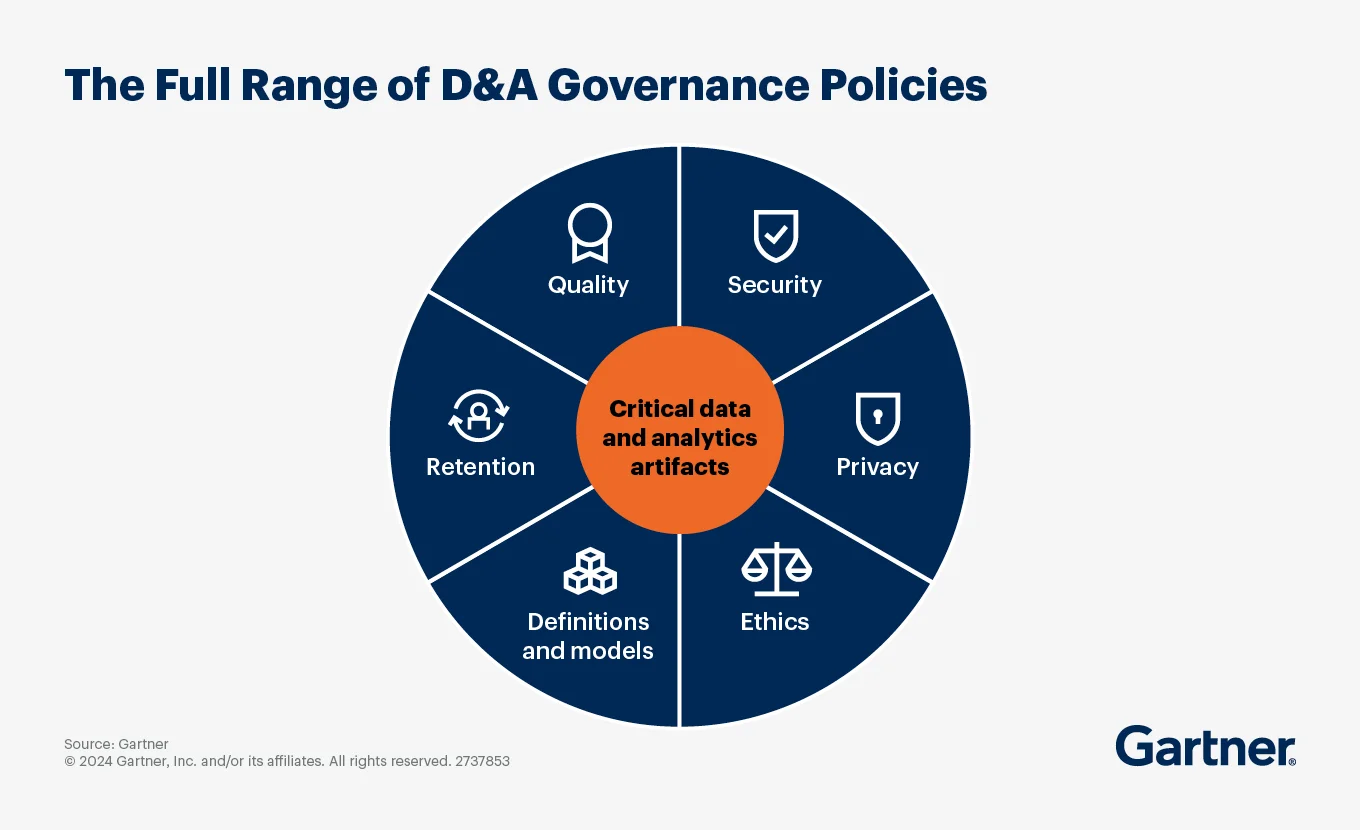
Essential data and analytics governance policies for modern enterprises - Source: Gartner.
To get you started, here’s a list of six data policy types essential for effective governance of your data estate, according to Gartner:
- Data quality policies: Ensure that your data assets are fit for purpose by setting standards for data quality dimensions such as, validity, completeness, timeliness, accuracy, integrity.
- Data privacy policies: Focus on establishing accountability, transparency, purposeful processing and control over personal data to reduce compliance risks.
- Data security policies: Define access controls and protection mechanisms for your data estate to reduce the business and financial risks of security breaches.
In many cases, security and privacy policies overlap, leading organizations to develop comprehensive data protection policies that address both concerns.
- Data retention policies: Focus on the life cycles of D&A artifacts — how long they are retained and archived, and when they are disposed of. Retention policies also intersect with privacy policies, particularly when handling personal data.
- Ethics policies: Guide responsible AI deployment and ensure alignment with enterprise values. They’re essential for reducing risks like bias, misinformation, and unintended consequences of AI models.
- Definitions and models policies: Ensure consistency in formats, semantics and terminologies to create a shared understanding of data across the organization. They define key concepts and common models, and often focus on broadly used artifacts such as master data domains and critical business KPIs.
Data policy setting tools: Four must-have product capabilities
Permalink to “Data policy setting tools: Four must-have product capabilities”Data policy setting is a part of a broader data, analytics, and AI governance program. As such, the must-have product capabilities for data policy setting should be built on the principles of automation and AI, openness and extensibility, personalization, and a unified control plane.
Core capabilities of such tools include:
- AI-assisted policy creation: Write data governance policies at scale with AI
- Governance by exception: Add exceptions to your policies for every edge case
- Policy approval workflows: No-code setup and frictionless approvals
- Open API architecture: Be future-ready with the ability to design policies for every edge case
Let’s break down each capability.
1. AI-assisted policy creation
Permalink to “1. AI-assisted policy creation”Each data governance policy should have the following:
- A clear purpose: The mission statement of your policy outlining its objective
- A detailed description: Provide more context on the policy with best practices, goals, and guidelines
- Asset scope: Identify the assets to which a particular policy you’re drafting is applicable
- Compliance rules: Map a set of rules to specify permitted or restricted actions based on metadata attributes such as ownership, certification, asset classification, tags and custom metadata
- Validity period: Define when the policy will expire, and consequently, when it should be reviewed
AI can help you document the above at scale, while automation can speed up the compliance rule propagation as well as updates.
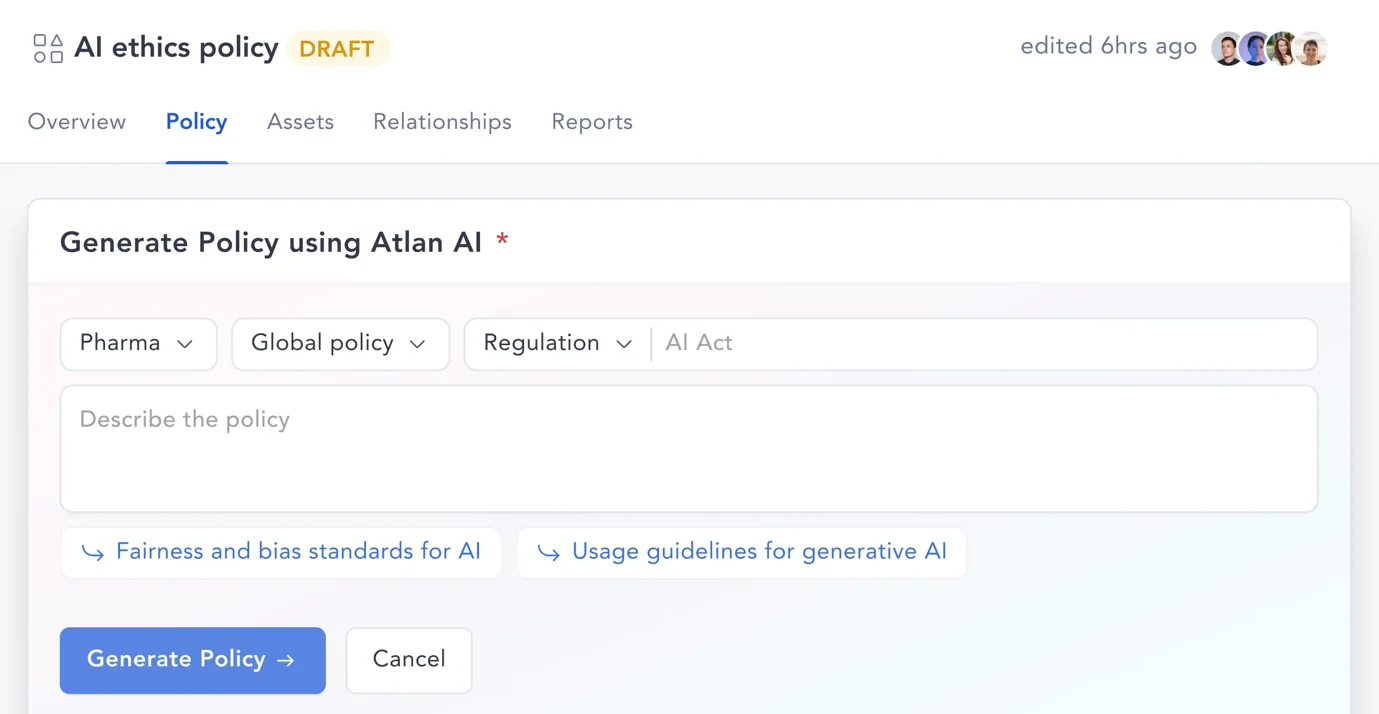
An example of AI-assisted policy creation - Source: Atlan.
So, look for a data policy setting tool embedded with automation and AI to accelerate data
governance initiatives, reduce governance overhead, and free up valuable time.
2. Governance by exception
Permalink to “2. Governance by exception”The best way to reduce potential business problems from improper use of data is with real-time incident flagging, response, and remediation along with exceptions for every edge case.
Translating this to features, look for data policy tools with:
- Real-time incident alerts about policy incidents and breaches when and where they happen
- The flexibility to grant exceptions to authorized individuals or entities, allowing them to circumvent one or more restrictions
This approach reduces operational friction while ensuring governance remains effective.
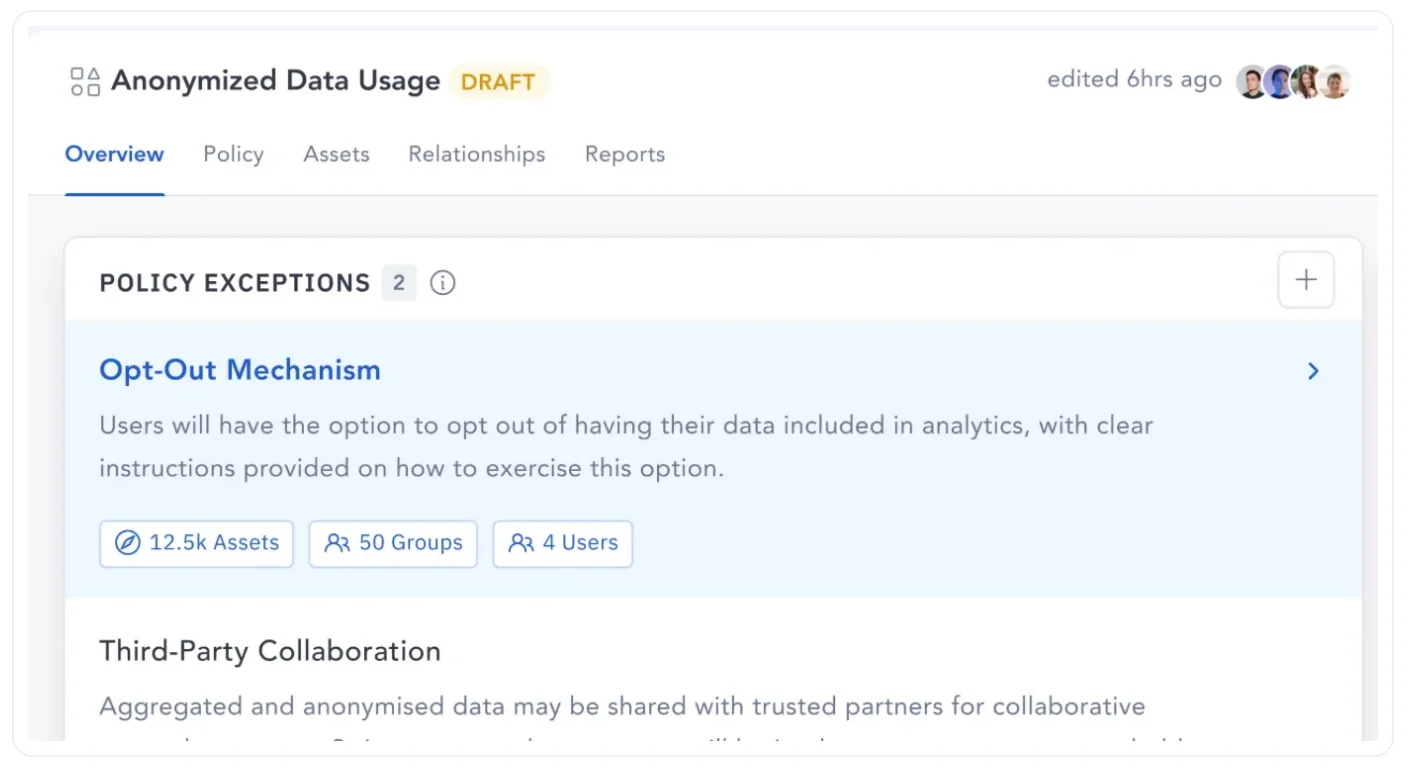
Governance by exception in action - Source: Atlan.
3. No-code policy approval workflows
Permalink to “3. No-code policy approval workflows”Once your data governance policy is defined, you must submit it for approval to ensure all stakeholders review, understand, and sign off on it.
Look for a data policy setting tool that lets you develop policy approval workflows within minutes with a no-code setup and predefined workflow templates. In this scenario, you can build the data policy approval workflow by yourself using drag-and-drop features.
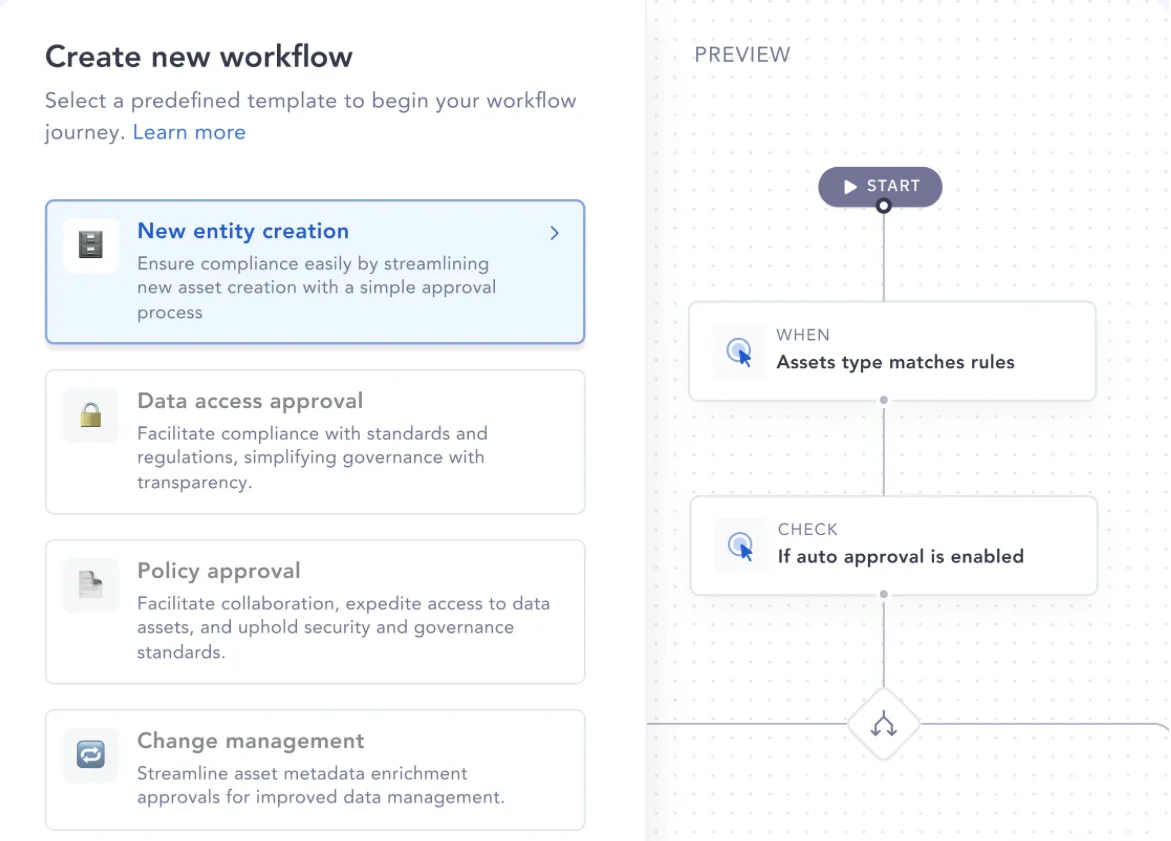
An example of a no-code data policy approval workflow - Source: Atlan.
Once more, a tool with embedded automation and AI will help you scale the policy approval process, along with updates/revisions and real-time notifications (to be sent to relevant stakeholders). This eliminates bottlenecks and accelerates governance.
4. Open API architecture and endless extensibility
Permalink to “4. Open API architecture and endless extensibility”Open API architecture lets you account for diverse, ever-changing data technology and use cases. You can integrate with the technologies of your choice and build custom solutions –connectors for in-house systems and automated alerts & workflows.
An open design and endless extensibility would standardize and streamline policy coverage for your entire data estate. So, look for a data policy setting tool that creates an extensible self-service layer for policy coverage in a single platform.

An endlessly open and extensible data governance platform can integrate with numerous tools via open APIs - Source: Atlan.
Data policy setting tools: How Atlan’s metadata control plane offers a holistic approach
Permalink to “Data policy setting tools: How Atlan’s metadata control plane offers a holistic approach”Atlan’s data & AI governance platform, powered by active metadata, enables scalable, automated, and future-ready policy setting and enforcement with:
- An open, extensible metadata lakehouse infrastructure that solves for the challenges of increasing data scale and diversity
- A policy center that provides a single control plane to link your data governance policies to data assets
- Coverage for the full-range of data governance policies – quality, privacy, security, retention, ethics, and definitions and models
- Data policy setting documentation powered by automation and AI
You can use Atlan to build policies that align with your organization’s goals for securing and managing data.
How Tide embedded privacy into automated processes to improve GDPR compliance
Permalink to “How Tide embedded privacy into automated processes to improve GDPR compliance”UK-based digital bank Tide wanted to improve its compliance with GDPR’s Right to Erasure, commonly known as the “Right to be forgotten”, at scale.
“We wanted to embed data protection and privacy into our running processes, rather than discussing it at the end of projects.” - Hendrik Brackmann, VP of Data at Tide
Although Tide’s production support team had a script to automate the process, it didn’t capture data from all the new sources that kept appearing in the organization, just the key data source. So, GDPR compliance was still largely manual.
Tide’s solution was to:
- Make the compliance requirement a team OKR
- Understand where data was stored and how it was processed
- Identify who owned such assets
- Set up a cross-functional working group to develop a shared understanding of data assets
After that, Tide used Atlan to:
- Build single source of truth for personal data – documenting data asset definitions, scope, ownership, lineage, and more
- Set up rule-based automation (Atlan Playbooks) to identify, tag, and then classify the data in a single, automated workflow
- Anonymize data in accordance with GDPR standards for de-identification and Tide’s data retention obligations
Business impact: Tide improved and scaled GDPR compliance within hours, not months
Wrapping up
Permalink to “Wrapping up”Data policy setting tools ensure compliance, security, and governance efficiency by defining and automating data policies. With AI, automation, and open APIs, they help organizations proactively enforce policies at scale.
A metadata control plane like Atlan simplifies data policy setting, ensuring that your data governance efforts can keep up the pace with evolving regulations and technology.
FAQs on Data Policy Setting Tools
Permalink to “FAQs on Data Policy Setting Tools”What are data policy setting tools?
Permalink to “What are data policy setting tools?”Data policy setting tools help define, approve, enforce, and monitor governance policies across data and analytics assets. These tools ensure that policies are properly created and enforced, aligning with business outcomes and compliance needs.
Why are AI-assisted policy creation tools important?
Permalink to “Why are AI-assisted policy creation tools important?”AI-assisted tools streamline the process of creating policies by automating tasks like drafting purpose, compliance rules, and asset scope, making it easier to manage governance at scale.
What is governance by exception?
Permalink to “What is governance by exception?”Governance by exception allows for flexibility in governance by flagging incidents in real time and granting authorized exceptions for edge cases, reducing friction while maintaining control.
What is a no-code policy approval workflow?
Permalink to “What is a no-code policy approval workflow?”A no-code policy approval workflow enables users to set up and approve data governance policies without writing code, using drag-and-drop tools to build workflows quickly.
How do open API architectures benefit data policy setting tools?
Permalink to “How do open API architectures benefit data policy setting tools?”Open API architectures ensure future readiness by allowing seamless integration with existing tools and systems, providing flexibility to design custom governance solutions.
Data policy setting tools: Related reads
Permalink to “Data policy setting tools: Related reads”- What is Data Governance? Its Importance, Principles & How to Get Started?
- Data Governance Framework: Examples, Templates, Standards, Best Practices & How to Create One?
- Key Objectives of Data Governance: How Should You Think About Them?
- Data Governance Strategy: How To Get Started?
- How to Implement Data Governance: Steps, Prerequisites, Essential Factors & Business Case
- How to Improve Data Governance: Steps, Tips & Template
- 7 Steps to Simplify Data Governance for Your Entire Organization
- Automated Data Governance: How Does It Help You Manage Access, Security & More at Scale?
- Enterprise Data Governance Basics, Strategy, Key Challenges, Benefits & Best Practices
- Data Governance and Compliance: An Act of Checks & Balances
- Data Compliance Management in 2025
- Data Governance and GDPR: A Comprehensive Guide to Achieving Regulatory Compliance
- Data Governance in Banking: Benefits, Challenges, Capabilities
- Financial Data Governance: Strategies, Trends, Best Practices
- BCBS 239 Data Governance: What Banks Need to Know in 2025
- Data Governance & Business Intelligence: Why Their Integration Matters and How It is Crucial for Business Success?
- Unified Control Plane for Data: The Future of Data Cataloging
- Data Governance Policy: A Complete Guide with Examples & Templates
Share this article

